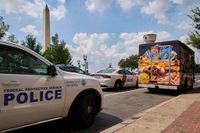Washington, D.C. is facing a troubling economic milestone: for the third month in a row, it has the highest unemployment rate of any state or territory in the United States. According to new data released on August 19, 2025, by the Bureau of Labor Statistics (BLS), D.C.'s seasonally adjusted unemployment rate reached 6% in July, outpacing every other jurisdiction in the nation. This statistic is more than just a number—it's the result of a perfect storm of policy decisions, shifting economic forces, and global trends converging on the nation’s capital.
The roots of D.C.'s unemployment woes reach back to earlier this year, when President Donald Trump's Department of Government Efficiency initiated sweeping layoffs across federal agencies. The move, part of a broader effort to streamline government, has led to thousands of federal workers either being laid off or asked to voluntarily resign since the start of Trump's second term. These actions have triggered a wave of litigation from labor unions and advocacy groups, who argue that the cuts are not only devastating to families but threaten the effectiveness of critical government services.
"The layoffs are going to make the Black-white unemployment gap in D.C. worse," the DC Fiscal Policy Institute warned, pointing to the disproportionate impact federal job cuts can have on Black workers in the city. According to the latest figures from the D.C. Office of Revenue Analysis, the toll of these layoffs is evident in the city’s rising unemployment payout numbers. In April, unemployed federal workers in the District received $2.01 million in unemployment payments—a figure that ballooned to $2.57 million by June. That’s a sharp month-over-month increase, underscoring the scale and speed of the crisis.
Neighboring states have felt some ripple effects, but not to the same degree. Maryland’s unemployment rate edged up to 3.4% in July from 3.3%, while Virginia’s ticked up to 3.6% from 3.5%. Both remain well below D.C.'s 6%. Nationally, the jobless rate sits at 4.2%, with South Dakota boasting the lowest at just 1.9%, according to BLS data.
The federal layoffs are only one part of the story. D.C. relies heavily on international tourism, and that sector has taken a significant hit in 2025. According to the World Travel & Tourism Council, international visitor spending in the U.S. is projected to fall to just under $169 billion this year, down from $181 billion in 2024—a 22.5% drop from the previous peak. The reasons for the decline are complex: many travelers, especially from Britain, Germany, and South America, are staying away due to President Trump's tariffs, his administration’s rhetoric, and reports of tourists being arrested at the U.S. border. The result? Fewer visitors, less spending, and more pressure on service sector jobs in the capital.
One food truck owner on the National Mall experienced the intersection of these forces firsthand. On August 15, 2025, his truck was towed after Immigration and Customs Enforcement (ICE) officers questioned his employees about their immigration status. He was told the truck’s tires were unsafe, despite his insistence that it had recently passed a D.C. inspection. The incident, captured in an Associated Press photograph, highlights the increased immigration enforcement presence in the city and the uncertainty facing small business owners who rely on both visitors and immigrant labor.
President Trump and a coalition of Republican governors have responded to D.C.'s challenges with a show of force, deploying National Guard troops to the city in hopes of reducing crime and tightening immigration enforcement. While city officials report that crime is already on the decline, the move has sparked debate over its necessity and effectiveness. Some residents see it as a needed step to ensure safety and order, while others worry it sends the wrong message to both locals and tourists.
The Trump administration’s approach to shrinking the federal workforce was given a green light by the Supreme Court in July, even as critics warned that the decision could lead to the loss of vital government services and put hundreds of thousands of employees out of work. Labor unions and advocacy groups have mounted legal challenges, but so far, the administration’s policies remain in effect.
For D.C., the consequences are visible not only in the unemployment statistics but across the city’s neighborhoods. The increase in joblessness is particularly acute among African American residents, who have long depended on federal employment as a path to middle-class stability. The DC Fiscal Policy Institute’s warning about the Black-white unemployment gap is not just theoretical—it reflects the lived experience of many in the city.
D.C.'s economic woes are compounded by the broader national and global context. The U.S. economy as a whole is grappling with a slowdown in international tourism, which has ripple effects for cities like Washington that depend on foreign visitors for a significant portion of their revenue. The World Travel & Tourism Council’s projection of a $12 billion drop in spending from 2024 to 2025 is a sobering indicator of the headwinds facing the industry.
Meanwhile, the political and legal battles over federal employment are far from settled. Litigation continues as unions fight to protect jobs and services, while the Trump administration and its allies argue that downsizing is essential to creating a leaner, more efficient government. The Supreme Court’s ruling has shifted the balance in favor of the administration for now, but the debate is unlikely to subside anytime soon.
For many D.C. residents, the question is what comes next. Will the city’s economy find a new footing as it adjusts to fewer federal jobs and less tourism? Or will the pain linger, deepening divides and forcing a reckoning with the city’s dependence on government and global visitors alike?
One thing is clear: Washington, D.C. stands at a crossroads. The decisions made in the months ahead—by policymakers, business owners, and residents—will shape the city’s recovery and its future. As the numbers show, the stakes are high, and the eyes of the nation are watching.





